Tailieumoi.vn xin giới thiệu Trắc nghiệmTiếng Anh lớp 6 Unit 6: Our Tet holiday sách Global Success. Bài viết gồm 100 câu hỏi trắc nghiệm với đầy đủ các mức độ và có hướng dẫn giải chi tiết sẽ giúp học sinh ôn luyện kiến thức và rèn luyện kĩ năng làm bài trắc nghiệm Tiếng Anh 6. Mời các bạn đón xem:
Trắc nghiệm Tiếng Anh 6 Unit 6: Our Tet holiday
1. Trắc nghiệm Từ vựng: Our Tet holiday
Câu 1: Choose the best answer to complete the sentence. (Em hãy lựa chọn đáp án đúng nhất để hoàn thành câu)
At Tet people wish each other a _____ and _____ life.
A. long/unhealthy
B. short/healthy
C. long/healthy
D. big/bad
Đáp án: C
Giải thích:
Long (dài)>< short (ngắn) (adj)
Healthy (khỏe mạnh) >< unhealthy (không khỏe mạnh) (adj)
Big (adj) to lớn
Bad (adj) tệ hại
Vì đây là điều ước (wish) nên mong muốn về cuộc sống phải là một cuộc sống tốt đẹp
=> At Tet people wish each other a long and healthy life.
Tạm dịch: Vào Tết mọi người chúc nhau sống lâu và khỏe mạnh.
Câu 2: Choose the best answer to complete the sentence. (Em hãy lựa chọn đáp án đúng nhất để hoàn thành câu)
Before Tet, people often give _____ to show their love and respect.
A. firecrackers
B. plants
C. food
D. presents
Đáp án: D
Giải thích:
firecrackers (n): pháo hoa
plants (n): cây
food (n): đồ ăn
presents (n): quà
=> Before Tet, people often give presents to show their love and respect.
Tạm dịch: trước ngày Tết, mọi người thường hay tặng quà để thể hiện tình cảm và sự tôn trọng lẫn nhau.
Câu 3: Choose the best answer to complete the sentence. (Em hãy lựa chọn đáp án đúng nhất để hoàn thành câu)
I often ______ with my mother before Tet. We buy a lot of food then.
A. visit grandparents
B. decorate house
C. clean house
D. go shopping
Đáp án: D
Giải thích:
visit grandparents: thăm ông bà
decorate house: trang trí nhà cửa
clean house: dọn dẹp nhà cửa
go shopping: đi mua sắm
=> I often go shopping with my mother before Tet. We buy a lot of food then.
Tạm dịch: tôi thường hay đi mua sắm với mẹ trước ngày Tết. Chúng tôi mua rất nhiều đồ ăn.
Câu 4: Choose the best answer to complete the sentence. (Em hãy lựa chọn đáp án đúng nhất để hoàn thành câu)
Children in Viet Nam always ________ lucky money form their parents or relatives on New Year’s Day.
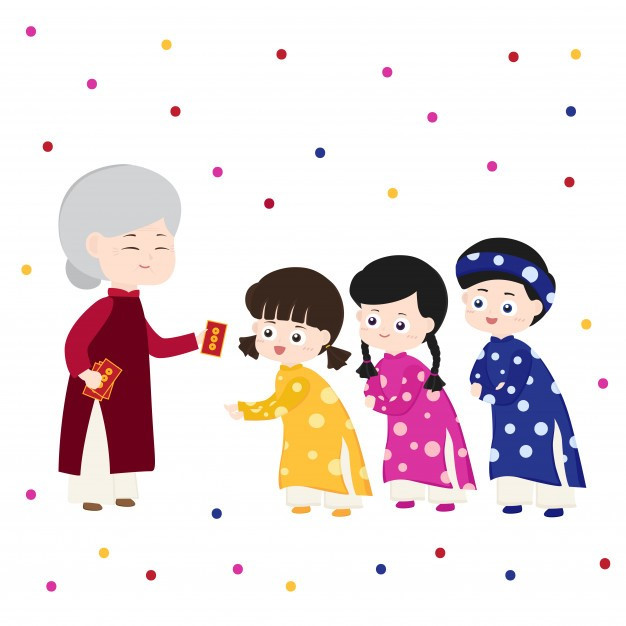
A. get
B. take
C. bring
D. give
Đáp án: A
Giải thích:
Get: nhận được (v)
Take: lấy đi, cầm đi (v)
Bring: mang theo (v)
Give: gửi (v)
=> Children in Viet Nam always get lucky money from their parents or relatives on New Year’s Day.
Tạm dịch: Trẻ em ở Việt Nam luôn nhận được tiền mừng tuổi từ cha mẹ hoặc người thân của mình vào ngày Tết.
Câu 5: Choose the best answer to complete the sentence. (Em hãy lựa chọn đáp án đúng nhất để hoàn thành câu)
People like to watch beautiful _____ on new year’s Eve.
A. cathedral
B. calendar
C. fireworks
D. pagoda
Đáp án: C
Giải thích:
Cathedral: thánh đường (n)
Calendar: lịch (n)
Fireworks: pháo hoa (n)
Pagoda: chùa (n)
=> People like to watch beautiful fireworks on New year’s Eve.
Tạm dịch: Mọi người thích xem những màn bắn pháo hoa tuyệt đẹp vào đêm giao thừa năm mới.
Câu 6: Choose the best answer to complete the sentence. (Em hãy lựa chọn đáp án đúng nhất để hoàn thành câu)
Children are often given ________ in red envelopes.
A. sticky rice
B. first footer
C. lucky money
D. festival
Đáp án: C
Giải thích:
sticky rice: xôi (n)
first footer: tiêu đề (n)
Lucky money: tiền mừng tuổi (n)
Festival: lễ hội (n)
=> Children are often given lucky money in red envelopes.
Tạm dịch: Trẻ em thường được trao tiền mừng tuổi trong phong bì màu đỏ.
Câu 7: Choose the best answer to complete the sentence. (Em hãy lựa chọn đáp án đúng nhất để hoàn thành câu)
The _________ is the first person to enter a house at the beginning of a lunar year.
A. host
B. celebrator
C. first-footer
D. calendar
Đáp án: C
Giải thích:
Host: chủ nhà (n)
Celebrator: người ăn mừng (n)
first-footer: khách xông nhà (n)
calendar: lịch (n)
=> The first-footer is the first person to enter a house at the beginning of a lunar year.
Tạm dịch: khách xông nhà là người đầu tiên vào nhà vào đầu năm âm lịch.
Câu 8: Choose the best answer to complete the sentence. (Em hãy lựa chọn đáp án đúng nhất để hoàn thành câu)
At Tet, many people present rice to wish ______ enough food throughout the year.
A. in
B. at
C. for
D. with
Đáp án: C
Giải thích:
Cụm từ: wish for st (cầu mong điều gì)
=> At Tet, many people present rice to wish for enough food throughout the year.
Tạm dịch: Vào dịp Tết, nhiều người có mặt để ước có đủ lương thực trong suốt cả năm.
Câu 9: Choose the best answer to complete the sentence. (Em hãy lựa chọn đáp án đúng nhất để hoàn thành câu)
I will _____ my lucky money in my piggy bank.

A. give
B. keep
C. spend
D. borrow
Đáp án: B
Giải thích:
Give: gửi (v)
Keep: giữ (v)
Spend: dành (v)
Borrow: mượn (v)
=> I will keep my lucky money in my piggy bank.
Tạm dịch: Tôi sẽ giữ tiền mừng tuổi của mình trong con heo đất của mình.
Câu 10: Choose the best answer to complete the sentence. (Em hãy lựa chọn đáp án đúng nhất để hoàn thành câu)
When New Year comes, people in different countries always wear their _____ clothes.
A. tradition
B. normal
C. ordinary
D. traditional
Đáp án: D
Giải thích:
Tradition: truyền thống (n)
Normal: đơn giản (adj)
Ordinary: cơ bản (adj)
Traditional: có tính truyền thống (adj)
Chỗ cần điền là một tính từ bổ sung ý nghĩa cho danh từ clothes (quần áo), dựa vào ngữ nghĩa của câu ta chọn traditional
=> When New Year comes, people in different countries always wear their traditional clothes.
Tạm dịch: Khi năm mới đến, người dân ở các quốc gia khác nhau luôn mặc quần áo truyền thống của mình.
Câu 11: Choose the best answer to complete the sentence. (Em hãy lựa chọn đáp án đúng nhất để hoàn thành câu)
Before Tet, people often clean and _______ their house.
A. decorated
B. decorate
C. decorating
D. decoration
Đáp án: B
Giải thích:
Liên từ “and” (và) nối giữa 2 từ có cùng cấu tạo và loại từ. Clean (dọn dẹp) và động từ nguyên thể => chỗ cần điền cũng là động từ nguyên thể
- decorate (v): trang trí
=> Before Tet, people often clean and decorate their house.
Tạm dịch: Trước Tết, mọi người thường dọn dẹp và trang trí nhà cửa.
Câu 12: Choose the best answer to complete the sentence. (Em hãy lựa chọn đáp án đúng nhất để hoàn thành câu)
On Tet holiday, Vietnamese people often visit _____.
A. relatives
B. rubbish
C. feather
D. first-footer
Đáp án: A
Giải thích:
Relatives: họ hàng (n)
Rubbish: rác (n)
Feather: lông vũ (n)
first-footer: tiêu để (n)
=> On Tet holiday, Vietnamese people often visit relatives.
Tạm dịch: Vào dịp tết, người Việt thường đến thăm họ hàng.
Câu 13: Choose the best answer to complete the sentence. (Em hãy lựa chọn đáp án đúng nhất để hoàn thành câu)
Tet is a time for family _____.
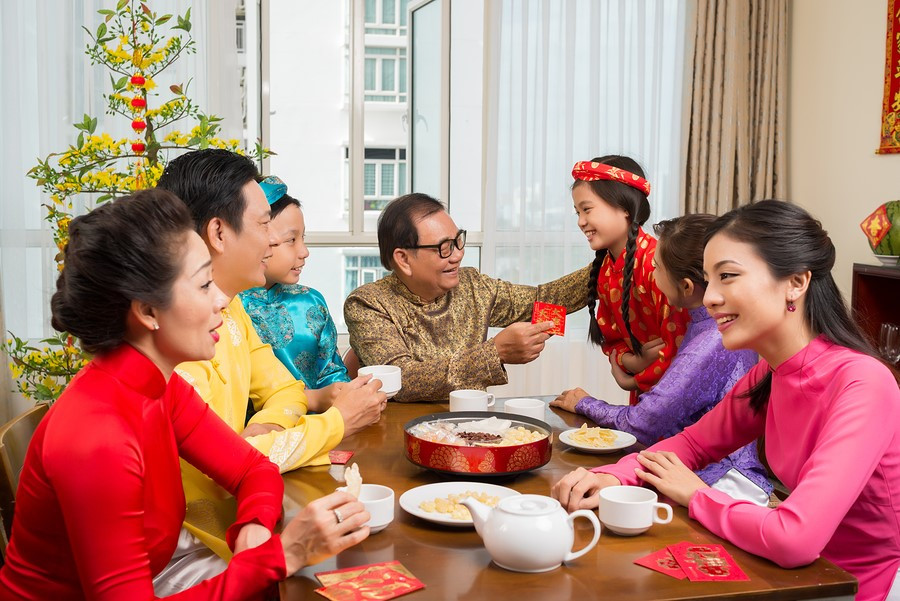
A. cooking
B. working
C. paying
D. gathering
Đáp án: D
Giải thích:
Cook: nấu ăn (v)
Work: làm việc (v)
Pay: trả (v)
Gather: sum vầy (v)
=> Tet is a time for family gathering.
Tạm dịch: Tết là thời gian để gia đình sum vầy.
Câu 14: Choose the best answer to complete the sentence. (Em hãy lựa chọn đáp án đúng nhất để hoàn thành câu)
We always ______ our wedding anniversary by going out to dinner.
A. wish
B. celebrate
C. decorate
D. remote
Đáp án: B
Giải thích:
Wish: ước (v)
Celebrate: kỉ niệm (v)
Decorate: trang trí (v)
Remote: xa xôi, hẻo lánh (adj)
=> We always celebrate our wedding anniversary by going out to dinner.
Tạm dịch: Chúng tôi luôn kỷ niệm ngày cưới bằng cách đi ăn tối.
Câu 15: Choose the best answer to complete the sentence. (Em hãy lựa chọn đáp án đúng nhất để hoàn thành câu)
What is this?
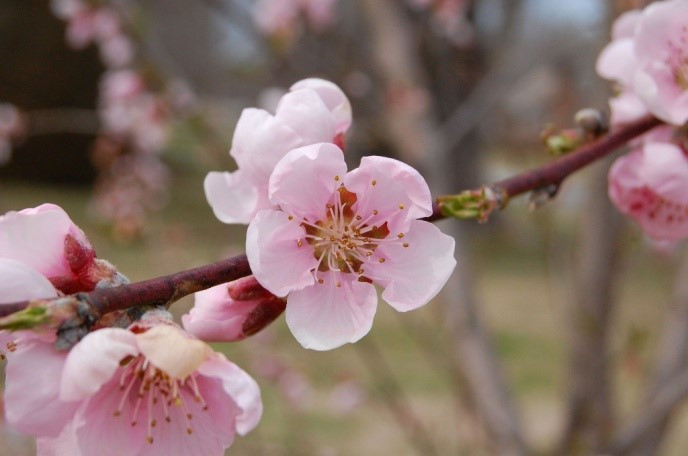
A. Kumquat tree
B. Apricot blossom
C. Peach blossom
D. The new year tree
Đáp án: C
Giải thích:
Kumquat tree: cây quất (n)
Apricot blossom: cây mai (n)
Peach blossom: cây đào (n)
The new year tree: cây năm mới (n)
Trong ảnh là cây đào.
2. Trắc nghiệm Ngữ âm: /S/ & /Ʃ/
Câu 1: Choose the word which has the underlined part pronounced differently from the rest.
A. strip
B. science
C. usually
D. stop
Đáp án: C
Giải thích:
strip: /strɪp/
science: /ˈsaɪəns/
usually: /ˈjuːʒuəli/
stop: /stɒp/
Câu C phát âm là / ʒ / còn lại là / s /
Câu 2: Choose the word which has the underlined part pronounced differently from the rest.
A. Russia
B. class
C. glass
D. pass
Đáp án: A
Giải thích:
Russia: /ˈrʌʃə/
class: /klɑːs/
glass: /ɡlɑːs/
pass: /pɑːs/
Câu A phát âm là / ʃ / còn lại là / s /
Câu 3: Choose the word which has the underlined part pronounced differently from the rest.
A. fix
B. exam
C. six
D. next
Đáp án: B
Giải thích:
fix: /fɪks/
exam: /ɪɡˈzæm/
six: /sɪks/
next: /nekst/
Câu B phát âm là / z / còn lại là / ks /
Câu 4: Choose the word which has the underlined part pronounced differently from the rest.
A. same
B. see
C. sister
D. sure
Đáp án: D
Giải thích:
same: /seɪm/
see: /siː/
sister: /ˈsɪstə(r)/
sure: /ʃʊə(r)/
Câu D phát âm là / ʃ / còn lại là / s /
Câu 5: Choose the word which has the underlined part pronounced differently from the rest.
A. cover
B. pencil
C. place
D. police
Đáp án: A
Giải thích:
cover: /ˈkʌvə(r)/
pencil: /ˈpensl/
place: /pleɪs/
police: /pəˈliːs/
Câu A phát âm là / k / còn lại là / s /
Câu 6: Choose the word which has the underlined part pronounced differently from the rest.
A. ocean
B. ceiling
C. city
D. circle
Đáp án: A
Giải thích:
ocean: /ˈəʊʃn/
ceiling: /ˈsiːlɪŋ/
city: /ˈsɪti/
circle: /ˈsɜːkl/
Câu A phát âm là / ʃ / còn lại là / s /
Câu 7: Choose the word which has the underlined part pronounced differently from the rest.
A. ache
B. school
C. machine
D. chemical
Đáp án: C
Giải thích:
ache: /eɪk/
school: /skuːl/
machine: /məˈʃiːn/
chemical: /ˈkemɪkl/
Câu C phát âm là / ʃ / còn lại là / k /
Câu 8: Choose the word which has the underlined part pronounced differently from the rest.
A. sure
B. stupid
C. spring
D. send
Đáp án: A
Giải thích:
sure: /ʃʊə(r)/
stupid: /ˈstjuːpɪd/
spring: /sprɪŋ/
send: /send/
Câu A phát âm là / ʃ / còn lại là / s /
Câu 9: Choose the word which has the underlined part pronounced differently from the rest.
A. student
B. singer
C. summer
D. tables
Đáp án: D
Giải thích:
student: /ˈstjuːdnt/
singer: /ˈsɪŋə(r)/
summer: /ˈsʌmə(r)/
tables: /ˈteɪblz/
Câu D phát âm là / z / còn lại là / s /
Câu 10: Choose the word which has the underlined part pronounced differently from the rest.
A. december
B. century
C. cook
D. cinema
Đáp án: C
Giải thích:
december: /dɪˈsembə(r)/
century: /ˈsentʃəri/
cook: /kʊk/
cinema: /ˈsɪnəmə/
Câu C phát âm là / k / còn lại là / s /
3. Trắc nghiệm Ngữ pháp: Động từ khuyết thiếu “should”
Câu 1: Nối tình huống ở cột A với lời khuyên ở cột B.
Someone is going to live overseas. You should see a doctor.
Someone is felling hot and has a headache. You should take an umbrella.
It’s raining. You should learn the language before you go.
Someone has to get up early in the morning. You should take a rest.
Someone is tired out. You should set your alarm clock.
Đáp án:
Giải thích:
Tạm dịch cột tình huống:
1. Someone is going to live overseas. => Ai đó sẽ sống ở nước ngoài.
2. Someone is felling hot and has a headache. => Có người đang cảm thấy nóng và đau đầu.
3. It’s raining. => Trời đang mưa.
4. Someone has to get up early in the morning.=> Có người phải dậy sớm vào buổi sáng.
Tạm dịch lời khuyên:
a. You should see a doctor. => Bạn nên đi khám bác sĩ.
b. You should take an umbrella => Bạn nên lấy một cái ô.
c. You should learn the language before you go. => Bạn nên học ngôn ngữ trước khi đi.
d. You should take a rest. => Bạn nên nghỉ ngơi.
e. You should set your alarm clock. => Bạn nên đặt đồng hồ báo thức của bạn.
Câu 2: should or shouldn’t? (Em hãy kéo thả đáp án đúng vào chỗ trống.)
should
shouldn't
It’s so dark out there. You….bring an umbrella.
Đáp án:
Giải thích:
should: nên
shouldn't: không nên
- Cấu trúc khuyên ai nên làm gì: S+should+V_infi
- Cấu trúc khuyên ai không nên làm gì:
S+should not/ shouldn't +V_infi
Dựa vào ngữ cảnh câu trước (Trời đng tối dần, chúng ta... mang theo ô), ta chọn should để khuyên ai đó.
Đáp án: It’s so dark out there. You should bring an umbrella.
Tạm dịch: Nó rất tối ngoài kia. Bạn nên mang theo một chiếc ô.
Câu 3: should or shouldn’t? (Em hãy kéo thả đáp án đúng vào chỗ trống.)
should
shouldn't
Tom …eat so many lollipops. It’s bad for his teeth.
Đáp án:
Giải thích:
Cấu trúc khuyên ai không nên làm gì: S+shouldn’t+V_infi
Đáp án: Tom shouldn’t eat so many lollipops. It’s bad for his teeth
Tạm dịch: Tom không nên ăn nhiều kẹo mút. Nó không tốt cho răng của anh ấy.
Câu 4: should or shouldn’t? (Em hãy kéo thả đáp án đúng vào chỗ trống.)
should
shouldn't
People …drive fast in the town centre.
Đáp án:
Giải thích:
Cấu trúc khuyên ai không nên làm gì: S+shouldn’t+V_infi
Đáp án: People shouldn’t drive fast in the town centre.
Tạm dịch: Mọi người không nên lái xe nhanh trong trung tâm thị trấn.
Câu 5: should or shouldn’t? (Em hãy kéo thả đáp án đúng vào chỗ trống.)
should
shouldn't
We …go somewhere exciting for our holiday.
Đáp án:
Giải thích:
Cấu trúc khuyên ai nên làm gì: S+should+V_infi
Đáp án: We should go somewhere exciting for our holiday.
Tạm dịch: Chúng ta nên đi đâu đó thú vị cho kỳ nghỉ.
Câu 6: should or shouldn’t? (Em hãy kéo thả đáp án đúng vào chỗ trống.)
should
shouldn't
He …give up smoking because it is harmful to his health.
Đáp án:
Giải thích:
Cấu trúc khuyên ai nên làm gì: S+should+V_infi
Đáp án: He should give up smoking because it is harmful to his health.
Tạm dịch: Anh ta nên từ bỏ thuốc lá vì nó có hại cho sức khỏe của anh ta.
Câu 7: Choose the best answer.
You ____ in a dark room like this.
A. should study
B. don't should study
C. shouldn’t study
D. don’t study
Đáp án: C
Giải thích:
Cấu trúc khuyên ai không nên làm gì: S+shouldn’t+V_infi
Đáp án: You shouldn’t study in a dark room like this.
Tạm dịch: Bạn không nên học trong một căn phòng tối như thế này.
Câu 8: Choose the best answer.
You ______ a good pair of shoes for jogging.
A. should have
B. have should
C. shouldn’t have
D. having
Đáp án: A
Giải thích:
Cấu trúc khuyên ai nên/không nên làm gì: S + should/ shouldn’t + V-infi
- Trong trường hợp trên là nên có 1 đôi giày => dùng should
=> You should have a good pair of shoes for jogging.
Tạm dịch: Bạn nên có một đôi giày tốt để đi bộ.
Câu 9: Choose the best answer.
You shouldn’t ____ late for school.
A. be
B. is
C. being
D. are
Đáp án: A
Giải thích:
Cấu trúc khuyên ai không nên làm gì: S+shouldn’t+V_infi
Đáp án: You shouldn’t be late for school.
Tạm dịch: Bạn không nên đi học muộn.
Câu 10: Choose the best answer.
Where ____ we go when we are in Ho Chi Minh City?
A. should
B. do
C. did
D. are
Đáp án: A
Giải thích:
Đây là câu hỏi xin ý kiến nên làm gì => dùng should
=> Where should we go when we are in Ho Chi Minh City?
Tạm dịch: Chúng ta nên đi đâu khi ở thành phố Hồ Chí Minh?
Câu 11: Choose the best answer.
I feel tired. I should _____ to bed early.
A. going
B. go
C. to go
D. went
Đáp án: B
Giải thích:
Cấu trúc khuyên ai nên làm gì: S+should+V-infi
=> I feel tired. I should go to bed early.
Tạm dịch: Tôi cảm thấy mệt. Tôi nên đi ngủ sớm.
4. Trắc nghiệm Ngữ pháp: Some & Any
Câu 1: Choose the best answer.
Is there any butter _____ in the refrigerator?
A. leave
B. to leave
C. leaving
D. left
Đáp án: D
Giải thích:
left (adj): còn lại
=> Is there any butter left in the refrigerator?
Tạm dịch: Có chút bơ nào còn lại trong tủ lạnh không?
Câu 2: Choose the best answer.
We don’t need ____ more white paintanan
A. any
B. some
C. many
D. a
Đáp án: A
Giải thích:
some: một ít (đứng trước danh từ đếm được số nhiều và ước danh từ không đếm được)
any: bất kỳ, nào (đứng trước danh từ đếm được số nhiều và danh từ không đếm được, thường dùng trong câu phủ định và câu hỏi)
many: nhiều (đứng trước danh từ đếm được số nhiều)
a: một (đứng trước danh từ đếm được số ít bắt đầu bằng 1 phụ âm)
=> We don’t need any more white paint.
Tạm dịch: Chúng tôi không cần thêm sơn trắng nữa.
Câu 3: Choose the best answer.
This evening I’m going out with ______ friends of mine.
A. any
B. some
C. much
D. a little
Đáp án: B
Giải thích:
some: một ít (đứng trước danh từ đếm được số nhiều và ước danh từ không đếm được)
any: bất kỳ, nào (đứng trước danh từ đếm được số nhiều và danh từ không đếm được)
much: nhiều (đứng trước danh từ không đếm được)
a little: có một ít đủ đề làm gì (đứng trước danh từ không đếm được)
=> friend là danh từ đếm được => ta dùng some
=> This evening I’m going out with some friends of mine.
Tạm dịch: Tối nay tôi đi chơi với vài người bạn.
Câu 4: Choose the best answer.
There is ____ tofu, but there aren’t _____ sandwiches.
A. some/some
B. any/any
C. some/any
D. any/some
Đáp án: C
Giải thích:
some: một ít (đứng trước danh từ đếm được số nhiều và ước danh từ không đếm được)
any: bất kỳ, nào (đứng trước danh từ đếm được số nhiều và danh từ không đếm được)
=> There is some tofu, but there aren’t any sandwiches.
Tạm dịch: Có một ít đậu phụ, nhưng không có chút bánh mì nào.
Câu 5: Choose the best answer.
I don’t have ______ oranges, but I have _____ apples.
A. any/any
B. some/any
C. any/some
D. a/some
Đáp án: C
Giải thích:
some: một ít (đứng trước danh từ đếm được số nhiều và ước danh từ không đếm được)
any: bất kỳ, nào (đứng trước danh từ đếm được số nhiều và danh từ không đếm được)
=> I don’t have any oranges, but I have some apples.
Tạm dịch: Tôi không có quả cam nào, nhưng tôi có một vài quả táo.
Câu 6: Choose the best answer.
– What would you like? - ___________.
A. I like some apple juice.
B. I’d like some apple juice.
C. I’d like any apple juice.
D. I’d like an apple juice.
Đáp án: B
Giải thích:
some: một ít, một vài (đứng trước danh từ không đếm được và danh từ đếm được số nhiều)
juice là danh từ không đếm được => ta dùng some
=> – What would you like? - I’d like some apple juice.
Tạm dịch: - Bạn muốn dùng gì? - Tôi muốn một ít nước táo.
Câu 7: Choose the best answer.
I have ____ homework to do for tomorrow.
A. an
B. some
C. any
D. a
Đáp án: B
Giải thích:
some: một ít (đứng trước danh từ đếm được số nhiều và ước danh từ không đếm được)
any: bất kỳ, nào (đứng trước danh từ đếm được số nhiều và danh từ không đếm được)
a: một (đứng trước danh từ đếm được số ít bắt đầu bằng 1 phụ âm)
an: một (đứng trước danh từ đếm được số ít bắt đầu bằng 1 nguyên âm)
homework là danh từ không đếm được => ta dùng some
=> I have some homework to do for tomorrow.
Tạm dịch: Tôi có một số bài tập về nhà để làm cho ngày mai.
Câu 8: Choose the best answer.
Would you like ___ cup of tea?
A. a
B. some
C. many
D. much
Đáp án: A
Giải thích:
a cup of tea: một tách trà
=> Would you like a cup of tea?
Tạm dịch: Bạn có muốn một tách trà không?
Câu 9: Choose the best answer.
I’ll get _______ butter while I’m at the shop.
A. any
B. a
C. some
D. many
Đáp án: C
Giải thích:
many: nhiều (đứng trước danh từ đếm được số nhiều)
some: một ít (đứng trước danh từ đếm được số nhiều và ước danh từ không đếm được)
any: bất kỳ, nào (đứng trước danh từ đếm được số nhiều và danh từ không đếm được)
a: một (đứng trước danh từ đếm được số ít bắt đầu bằng 1 phụ âm)
butter là danh từ không đếm được => ta dùng some
=> I’ll get some butter while I’m at the shop.
Tạm dịch: Tôi sẽ mua một ít bơ khi tôi ở cửa hàng.
Câu 10: Choose the best answer.
If there are ______ words you don’t understand, use a dictionary.
A. some
B. many
C. a few
D. any
Đáp án: D
Giải thích:
many: nhiều (đứng trước danh từ đếm được số nhiều)
some: một ít (đứng trước danh từ đếm được số nhiều và ước danh từ không đếm được)
a few: có một ít đủ để làm gì ( đứng trước danh từ đếm được số nhiều)
any: bất kỳ, nào (đứng trước danh từ đếm được số nhiều và danh từ không đếm được)
word là danh từ đếm được => ta dùng any
=> If there are any words you don’t understand, use a dictionary.
Tạm dịch: Nếu có bất kỳ từ nào bạn không hiểu, hãy sử dụng từ điển.
Câu 11: Put the word into the blank.
any
some
I’m afraid we don’t have … vegetables left in the fridge.
Đáp án: any
Giải thích:
any: bất kỳ, nào (dùng trong câu phủ định và câu hỏi, ngụ ý nghi ngờ)
=> I’m afraid we don’t have any vegetables left in the fridge.
Tạm dịch: Tôi sợ rằng chúng ta không có chút rau nào sót lại trong tủ lạnh.
Câu 12: Put the word into the blank.
some
no
Would you like …sugar in your coffee?
Đáp án: some
Giải thích:
some: một ít
no: không
=> Would you like some sugar in your coffee?
Tạm dịch: Bạn có muốn một chút đường trong cà phê không?
Câu 13: Put the word into the blank.
some
any
Can I have …water, please?
Đáp án: some
Giải thích:
water là danh từ không đếm được
some: một ít, một vài
=> Can I have some water, please?
Tạm dịch: Tôi có thể xin chút nước không?
5. Trắc nghiệm Reading đọc hiểu: Our Tet holiday
Câu 1: Read the passage carefully and choose the correct answer.
Every country has its own tradition when New Year comes. In Japan, at midnight on December 31, all temples in the country ring their bell 108 times. They believe that the ringing bells can remove their bad actions from the previous year.
In Thai Lan, the New Year is in April. It’s the hottest time of the year. People often throw water over the people. They believe that this activity will bring a lot of rain and wash away the bad things.
In Viet Nam, people clean and decorate their houses before Tet. They would like their houses to look more beautiful. The first footer is very important. They believe that the first footer on the first New Year Day decides the family’s luck for the whole year.
Một số từ vựng:
- tradition (n): truyền thống
- ring the bell: rung chuông
- wash away: rửa sạch, cuốn trôi
- luck (n): điều may mắn
People in Japan believe that 108 times of ringing bell can remove their _______ from the previous year.
A. good actions
B. rude actions
C. bad actions
D. x
Đáp án: C
Giải thích:
Tạm dịch các đáp án:
Người Nhật tin rằng 108 lần chuông rung có thể xua đuổi được .... từ những năm trước
A. hành động tốt
B. hành động thô lỗ
C. hành động xấu
Thông tin:
They believe that the ringing bells can remove their bad actions from the previous year.
Tạm dịch: Họ tin rằng tiếng chuông có thể loại bỏ những hành động xấu của họ từ năm trước.
Câu 2: Read the passage carefully and choose the correct answer.
Every country has its own tradition when New Year comes. In Japan, at midnight on December 31, all temples in the country ring their bell 108 times. They believe that the ringing bells can remove their bad actions from the previous year.
In Thai Lan, the New Year is in April. It’s the hottest time of the year. People often throw water over the people. They believe that this activity will bring a lot of rain and wash away the bad things.
In Viet Nam, people clean and decorate their houses before Tet. They would like their houses to look more beautiful. The first footer is very important. They believe that the first footer on the first New Year Day decides the family’s luck for the whole year.
Một số từ vựng:
- tradition (n): truyền thống
- ring the bell: rung chuông
- wash away: rửa sạch, cuốn trôi
- luck (n): điều may mắn
April is _______ time of the year in Thai Lan.
A. hot
B. the hottest
C. hottest
D. x
Đáp án: B
Giải thích:
Tạm dịch các đáp án:
Tháng tư là khoảng thời gian ____ trong năm ở Thái Lan.
A. nóng
B. nóng nhất
C. sai (thiếu 'the')
Thông tin:
In Thai Lan, the New Year is in April. It’s the hottest time of the year.
(Ở Thái Lan, năm mới đến vào tháng tư. Đó là thời điểm nóng nhất trong năm.)
Câu 3: Read the passage carefully and choose the correct answer.
Every country has its own tradition when New Year comes. In Japan, at midnight on December 31, all temples in the country ring their bell 108 times. They believe that the ringing bells can remove their bad actions from the previous year.
In Thai Lan, the New Year is in April. It’s the hottest time of the year. People often throw water over the people. They believe that this activity will bring a lot of rain and wash away the bad things.
In Viet Nam, people clean and decorate their houses before Tet. They would like their houses to look more beautiful. The first footer is very important. They believe that the first footer on the first New Year Day decides the family’s luck for the whole year.
Một số từ vựng:
- tradition (n): truyền thống
- ring the bell: rung chuông
- wash away: rửa sạch, cuốn trôi
- luck (n): điều may mắn
People in Thai Lan believe that throwing water over other people will _____ and wash away the bad things.
A. not bring a lot of rain
B. brings a lot of rain
C. bring a lot of rain
D. x
Đáp án: C
Giải thích:
Tạm dịch các đáp án:
Người Thái Lan tin rằng ném nước vào người khác sẽ _____ và rửa sạch được những điều xấu.
A. không mang đến nhiều mưa
B. mang lại nhiều mưa (sai vì sau 'will' + V-infi)
C. mang lại nhiều mưa
Thông tin:
They believe that this activity will bring a lot of rain and wash away the bad things.
(Họ tin rằng hoạt động này sẽ mang lại nhiều mưa và cuốn trôi những điều xấu.)
Câu 4: Read the passage carefully and choose the correct answer.
Every country has its own tradition when New Year comes. In Japan, at midnight on December 31, all temples in the country ring their bell 108 times. They believe that the ringing bells can remove their bad actions from the previous year.
In Thai Lan, the New Year is in April. It’s the hottest time of the year. People often throw water over the people. They believe that this activity will bring a lot of rain and wash away the bad things.
In Viet Nam, people clean and decorate their houses before Tet. They would like their houses to look more beautiful. The first footer is very important. They believe that the first footer on the first New Year Day decides the family’s luck for the whole year.
Một số từ vựng:
- tradition (n): truyền thống
- ring the bell: rung chuông
- wash away: rửa sạch, cuốn trôi
- luck (n): điều may mắn
What do Vietnamese people often do before Tet?
A. visit relatives
B. clean and decorate their house
C. throw water over the people
D. x
Đáp án: B
Giải thích:
Tạm dịch các đáp án:
Người Việt làm gì trước ngày Tết?
A. thăm họ hàng
B. dọn dẹp và trang trí nhà của họ
C. hất nước vào mọi người
Thông tin:
In Viet Nam, people clean and decorate their houses before Tet.
(Ở Việt Nam, người ta dọn dẹp và trang trí nhà cửa trước Tết.)
Câu 5: Read the passage carefully and choose the correct answer.
Every country has its own tradition when New Year comes. In Japan, at midnight on December 31, all temples in the country ring their bell 108 times. They believe that the ringing bells can remove their bad actions from the previous year.
In Thai Lan, the New Year is in April. It’s the hottest time of the year. People often throw water over the people. They believe that this activity will bring a lot of rain and wash away the bad things.
In Viet Nam, people clean and decorate their houses before Tet. They would like their houses to look more beautiful. The first footer is very important. They believe that the first footer on the first New Year Day decides the family’s luck for the whole year.
Một số từ vựng:
- tradition (n): truyền thống
- ring the bell: rung chuông
- wash away: rửa sạch, cuốn trôi
- luck (n): điều may mắn
The first people who comes to someones house on the first day are called _______.
A. first comer
B. the first
C. the first footer
D. x
Đáp án: C
Giải thích:
Tạm dịch câu hỏi: Người đầu tiên bước vào nhà người khác trong ngày đầu tiên được gọi là người xông nhà (the first footer)
Thông tin: They believe that the first footer on the first New Year Day decides the family’s luck for the whole year.
Tạm dịch: Họ tin rằng người xông nhà rất quan trọng trong ngày đầu tiên của năm mới vì người xông nhà sẽ quyết định vận may trong cả năm.)
Xem Bài Dịch
Mỗi quốc gia có truyền thống riêng của mình để đón năm mới. Tại Nhật Bản, vào nửa đêm ngày 31 tháng 12, tất cả các ngôi đền trong cả nước đều rung chuông 108 lần. Họ tin rằng tiếng chuông có thể loại bỏ những hành động xấu của họ từ năm trước.
Ở Thái Lan, năm mới đến vào tháng tư. Đó là thời điểm nóng nhất trong năm. Người ta thường ném nước lên người. Họ tin rằng hoạt động này sẽ mang lại nhiều mưa và cuốn trôi những điều xấu.
Ở Việt Nam, người ta dọn dẹp và trang trí nhà cửa trước Tết. Họ muốn ngôi nhà của họ trông đẹp hơn. Bước chân đầu tiên là rất quan trọng. Họ tin rằng bước chân đầu tiên vào ngày đầu năm mới quyết định vận may của gia đình trong cả năm.
Câu 6: Read the passage, choose the best answer.
Lunar New Year, or Tet, is Vietnam's main holiday. It is the most important occasion in the year which falls sometimes between 19th january and 20th February on the Western calendar. Tet marks the beginning of spring and the start of a new year.
Tet’s preparations and celebrations nowadays are shorter than those in the past. Streets are decorated with coloured lights and red banners. Shops are full of goods. People are busy buying gifts, cleaning and decorating their houses and cooking traditional foods.
Houses are often decorated with plants and flowers at this time. Peach blossom is traditional at Tet in the North while apricot blossom is traditional in the South. The kumquat tree with its ripe deep orange fruits is popular throughout the country. One of Tet’s most special foods is Banh Chung, which is made from sticky rice, green beans and fatty pork. Mut, which is candied fruits such as sugared apples, plums or tomatoes, is also popular.
* Một số từ mới:
- mark (v): đánh dấu
- preparation (n): sự chuẩn bị
- ripe deep orange fruits: quả chín vàng rộm
- plum (n): quả mận
What is another name of Tet?
A. Vietnamese holiday
B. Lunar New Year
C. Traditional holiday
D. Vietnam's main holiday
Đáp án: B
Giải thích:
Tạm dịch câu hỏi:
Một tên khác của Tết là gì?
A. Ngày lễ việt nam
B. Tết Nguyên đán
C. Ngày lễ truyền thống
D. Ngày lễ chính của Việt Nam
Thông tin:
Lunar New Year, or Tet, is Vietnam's main holiday.
Tạm dịch: Tết Nguyên đán, hay Tết, là ngày lễ chính của người Việt.
Câu 7: Read the passage, choose the best answer.
Lunar New Year, or Tet, is Vietnam's main holiday. It is the most important occasion in the year which falls sometimes between 19th january and 20th February on the Western calendar. Tet marks the beginning of spring and the start of a new year.
Tet’s preparations and celebrations nowadays are shorter than those in the past. Streets are decorated with coloured lights and red banners. Shops are full of goods. People are busy buying gifts, cleaning and decorating their houses and cooking traditional foods.
Houses are often decorated with plants and flowers at this time. Peach blossom is traditional at Tet in the North while apricot blossom is traditional in the South. The kumquat tree with its ripe deep orange fruits is popular throughout the country. One of Tet’s most special foods is Banh Chung, which is made from sticky rice, green beans and fatty pork. Mut, which is candied fruits such as sugared apples, plums or tomatoes, is also popular.
* Một số từ mới:
- mark (v): đánh dấu
- preparation (n): sự chuẩn bị
- ripe deep orange fruits: quả chín vàng rộm
- plum (n): quả mận
When does Tet sometimes take place on Western calendar?
A. from 19th January to 20th January
B. from 19th January to 19th February
C. from 19th January to 20th February
D. from 19th February to 20th February
Đáp án: C
Giải thích:
Tạm dịch câu hỏi:
Khi nào Tết diễn ra theo lịch Tây? (TH)
A. từ ngày 19 tháng 1 đến ngày 20 tháng 1
B. từ 19 tháng 1 đến 19 tháng 2
C. từ ngày 19 tháng 1 đến ngày 20 tháng 2
D. từ ngày 19 tháng 2 đến ngày 20 tháng 2
Thông tin: It is the most important occasion in the year which falls sometimes between 19th january and 20th February on the Western calendar.
(Đây là dịp quan trọng nhất trong năm đôi khi rơi vào giữa ngày 19 tháng 1 đến ngày 20 tháng 2 theo lịch phương Tây.)
Câu 8: Read the passage, choose the best answer.
Lunar New Year, or Tet, is Vietnam's main holiday. It is the most important occasion in the year which falls sometimes between 19th january and 20th February on the Western calendar. Tet marks the beginning of spring and the start of a new year.
Tet’s preparations and celebrations nowadays are shorter than those in the past. Streets are decorated with coloured lights and red banners. Shops are full of goods. People are busy buying gifts, cleaning and decorating their houses and cooking traditional foods.
Houses are often decorated with plants and flowers at this time. Peach blossom is traditional at Tet in the North while apricot blossom is traditional in the South. The kumquat tree with its ripe deep orange fruits is popular throughout the country. One of Tet’s most special foods is Banh Chung, which is made from sticky rice, green beans and fatty pork. Mut, which is candied fruits such as sugared apples, plums or tomatoes, is also popular.
* Một số từ mới:
- mark (v): đánh dấu
- preparation (n): sự chuẩn bị
- ripe deep orange fruits: quả chín vàng rộm
- plum (n): quả mận
What does Tet mark?
A. the end of the year
B. the start of a new month
C. the beginning of a new year
D. the beginning of spring and the start of a new year
Đáp án: D
Giải thích:
Tết đánh dấu điều gì?
A. kết thúc một năm.
B. khởi đầu tháng mới.
C. khởi đầu của một năm mới.
D. khởi đầu của mùa xuân và bắt đầu một năm mới.
Thông tin:
Tet marks the beginning of spring and the start of a new year.
(Tết đánh dấu sự khởi đầu của mùa xuân và bắt đầu một năm mới.)
Câu 9: Read the passage, choose the best answer.
Lunar New Year, or Tet, is Vietnam's main holiday. It is the most important occasion in the year which falls sometimes between 19th january and 20th February on the Western calendar. Tet marks the beginning of spring and the start of a new year.
Tet’s preparations and celebrations nowadays are shorter than those in the past. Streets are decorated with coloured lights and red banners. Shops are full of goods. People are busy buying gifts, cleaning and decorating their houses and cooking traditional foods.
Houses are often decorated with plants and flowers at this time. Peach blossom is traditional at Tet in the North while apricot blossom is traditional in the South. The kumquat tree with its ripe deep orange fruits is popular throughout the country. One of Tet’s most special foods is Banh Chung, which is made from sticky rice, green beans and fatty pork. Mut, which is candied fruits such as sugared apples, plums or tomatoes, is also popular.
* Một số từ mới:
- mark (v): đánh dấu
- preparation (n): sự chuẩn bị
- ripe deep orange fruits: quả chín vàng rộm
- plum (n): quả mận
What do people decorate streets with?
A. plants and flowers
B. coloured lights and red banners
C. peach blossom and apricot blossom
D. traditional foods
Đáp án: B
Giải thích:
Người ta trang trí đường phố bằng gì?
A. cây cối và hoa
B. đèn màu và biểu ngữ màu đỏ
C. hoa đào và hoa mai
D. món ăn truyền thống
Thông tin:
Streets are decorated with coloured lights and red banners.
(Đường phố được trang trí với đèn màu và biểu ngữ màu đỏ)
Câu 10: Read the passage, choose the best answer.
Lunar New Year, or Tet, is Vietnam's main holiday. It is the most important occasion in the year which falls sometimes between 19th january and 20th February on the Western calendar. Tet marks the beginning of spring and the start of a new year.
Tet’s preparations and celebrations nowadays are shorter than those in the past. Streets are decorated with coloured lights and red banners. Shops are full of goods. People are busy buying gifts, cleaning and decorating their houses and cooking traditional foods.
Houses are often decorated with plants and flowers at this time. Peach blossom is traditional at Tet in the North while apricot blossom is traditional in the South. The kumquat tree with its ripe deep orange fruits is popular throughout the country. One of Tet’s most special foods is Banh Chung, which is made from sticky rice, green beans and fatty pork. Mut, which is candied fruits such as sugared apples, plums or tomatoes, is also popular.
* Một số từ mới:
- mark (v): đánh dấu
- preparation (n): sự chuẩn bị
- ripe deep orange fruits: quả chín vàng rộm
- plum (n): quả mận
What do people do in Tet?
A. People buy gifts, clean and decorate their houses and cook traditional foods
B. People enjoy traditional food
C. People clean their house and wait for the first footer
D. People plant trees around their house
Đáp án: A
Giải thích:
Người ta làm gì vào dịp tết?
A. Mọi người mua quà tặng, dọn dẹp và trang trí nhà cửa và nấu các món ăn truyền thống.
B. Mọi người thưởng thức các món ăn truyền thống.
C. Mọi người dọn dẹp nhà cửa của họ và chờ đợi bước chân đầu tiên.
D. Người ta trồng cây quanh nhà.
Thông tin:
People are busy buying gifts, cleaning and decorating their houses and cooking traditional foods.
(Mọi người bận rộn mua quà tặng, dọn dẹp và trang trí nhà cửa và nấu các món ăn truyền thống.)
Xem Bài Dịch
Tết Nguyên đán, hay Tết, là ngày lễ chính của người Việt. Đây là dịp quan trọng nhất trong năm đôi khi rơi vào giữa ngày 19 tháng 1 đến ngày 20 tháng 2 theo lịch phương Tây. Tết đánh dấu sự khởi đầu của mùa xuân và bắt đầu một năm mới.
Việc chuẩn bị và tổ chức Tết ngày nay ngắn hơn so với trước đây. Đường phố được trang trí với đèn màu và biểu ngữ màu đỏ. Cửa hàng đầy hàng hóa. Mọi người bận rộn mua quà tặng, dọn dẹp và trang trí nhà cửa và nấu các món ăn truyền thống.
Nhà thường được trang trí bằng cây và hoa vào thời điểm này. Hoa đào là loài hoa truyền thống vào dịp Tết ở miền Bắc trong khi hoa mai là truyền thống ở miền Nam. Cây quất với quả màu cam chín rất phổ biến khắp cả nước. Một trong những món ăn đặc biệt nhất trong Tết là Bánh Chưng, được làm từ gạo nếp, đậu xanh và thịt lợn. Mứt, đó là các loại trái cây kẹo như táo có đường, mận hoặc cà chua, cũng rất phổ biến.
6. Trắc nghiệm Reading điền từ: Our Tet holiday
Câu 1: Fill in each numbered blank with one suitable word or phrase.
Tet is a national and (1) ______ festival in Viet Nam. It is occasion for every Vietnamese to be reunited to think (2) _____ their past activities and hope for good luck in the year to come. Before Tet all houses are white washed and (3)____ with yellow apricot flowers and colorful lanterns. Everybody is looking forward to a more favorable life. On the New Year's Eve, children are smartly dressed. They are hoping to (4) _____ money put in small red envelopes as they are wishing longevity (5) ______ their grandparents and parents.
Tet is a national and (1) ______ festival in Viet Nam.
A. traditional
B. modern
C. music
D. summer
Đáp án: A
Giải thích:
Tạm dịch các đáp án:
Traditional: truyền thống (adj)
Modern: hiện đại (adj)
Music: âm nhạc (n)
Summer: mùa hè (n)
=> Tet is a national and traditional festival in Viet Nam.
Tạm dịch: Tết là một lễ hội quốc gia và truyền thống của Việt Nam.
Câu 2: Fill in each numbered blank with one suitable word or phrase.
Tet is a national and (1) ______ festival in Viet Nam. It is occasion for every Vietnamese to be reunited to think (2) _____ their past activities and hope for good luck in the year to come. Before Tet all houses are white washed and (3)____ with yellow apricot flowers and colorful lanterns. Everybody is looking forward to a more favorable life. On the New Year's Eve, children are smartly dressed. They are hoping to (4) _____ money put in small red envelopes as they are wishing longevity (5) ______ their grandparents and parents.
It is occasion for every Vietnamese to be reunited to think (2) _____ their past activities and hope for good luck in the year to come.
A. to
B. after
C. for
D. about
Đáp án: D
Giải thích:
Tạm dịch các đáp án:
To: đến, tới
After: sau
For: cho
About: về
Cụm từ: think about (nghĩ về điều gì)
=> It is occasion for every Vietnamese to be reunited to think about their past activities and hope for good luck in the year to come.
Tạm dịch: Đây là dịp để mọi người Việt Nam được đoàn tụ để suy nghĩ về các hoạt động trong quá khứ của họ và hy vọng may mắn trong năm tới.
Câu 3: Fill in each numbered blank with one suitable word or phrase.
Tet is a national and (1) ______ festival in Viet Nam. It is occasion for every Vietnamese to be reunited to think (2) _____ their past activities and hope for good luck in the year to come. Before Tet all houses are white washed and (3)____ with yellow apricot flowers and colorful lanterns. Everybody is looking forward to a more favorable life. On the New Year's Eve, children are smartly dressed. They are hoping to (4) _____ money put in small red envelopes as they are wishing longevity (5) ______ their grandparents and parents.
Before Tet all houses are white washed and (3)____ with yellow apricot flowers and colorful lanterns.
A. decorate
B. decorates
C. decorating
D. decorated
Đáp án: D
Giải thích:
Decorate: trang trí (V)
Decorated: đã được trang trí (V_PII)
Liên từ “and” (và) nối giữa 2 từ có cùng loại từ và cấu trúc, ta thấy đây là cấu trúc câu bị động: be+V_PII
=> chỗ cần điền là động từ dạng quá khứ phân từ (decorated)
=> Before Tet all houses are white washed and decorated with yellow apricot flowers and colorful lanterns.
Tạm dịch: Trước Tết tất cả các ngôi nhà đều được quét vôi trắng và được trang trí bằng hoa mai vàng và đèn lồng nhiều màu sắc.
Câu 4: Fill in each numbered blank with one suitable word or phrase.
Tet is a national and (1) ______ festival in Viet Nam. It is occasion for every Vietnamese to be reunited to think (2) _____ their past activities and hope for good luck in the year to come. Before Tet all houses are white washed and (3)____ with yellow apricot flowers and colorful lanterns. Everybody is looking forward to a more favorable life. On the New Year's Eve, children are smartly dressed. They are hoping to (4) _____ money put in small red envelopes as they are wishing longevity (5) ______ their grandparents and parents.
They are hoping to (4) _____ money put in small red envelopes
A. buy
B. receive
C. sell
D. make
Đáp án: B
Giải thích:
Tạm dịch các đáp án:
Buy: mua
Receive: nhận
Sell: bán
Make: làm
Cụm từ: receive money (nhận tiền)
=> They are hoping to receive money put in small red envelopes.
Tạm dịch:,Họ đang hy vọng nhận được tiền bỏ vào những phong bì nhỏ màu đỏ.
Câu 5: Fill in each numbered blank with one suitable word or phrase.
Tet is a national and (1) ______ festival in Viet Nam. It is occasion for every Vietnamese to be reunited to think (2) _____ their past activities and hope for good luck in the year to come. Before Tet all houses are white washed and (3)____ with yellow apricot flowers and colorful lanterns. Everybody is looking forward to a more favorable life. On the New Year's Eve, children are smartly dressed. They are hoping to (4) _____ money put in small red envelopes as they are wishing longevity (5) ______ their grandparents and parents.
as they are wishing longevity (5) ______ their grandparents and parents.
A. for
B. to
C. with
D. from
Đáp án: A
Giải thích:
Tạm dịch các đáp án:
For: cho
To: đến, tới
With: với
From: từ
=> as they are wishing longevity for their grandparents and parents.
Tạm dịch: vì chúng đang mong ước ông bà và bố mẹ sống lâu cùng ông bà và bố mẹ.
Xem Bài Dịch
Tết là một lễ hội quốc gia và truyền thống ở Việt Nam. Đây là một dịp để mỗi người Việt Nam được đoàn tụ để suy nghĩ về các hoạt động trong quá khứ của họ và hy vọng may mắn trong năm tới. Trước Tết, tất cả nhà cửa đều được quét vôi trắng và trang trí bằng hoa mai vàng và đèn lồng nhiều màu sắc. Mọi người đều mong muốn một cuộc sống thuận lợi hơn. Vào đêm giao thừa, trẻ em ăn mặc rất đẹp. Chúng đang hy vọng nhận được tiền bỏ vào những phong bì nhỏ màu đỏ vì cầu chúc ông bà và cha mẹ sống lâu.
Câu 6: Choose the best answer to complete the sentences.
In our country, Vietnamese New Year (Tet holiday) is according to "lunar calendar", not "solar calendar". "Vietnamese New Year" is a very important holiday for Vietnamese people. Everyone will (1) _____ a break during the Vietnamese New Year. It is a time for rest and refreshment. Most of the business, stores, even the schools close (2) _________ a time.
On the "New Year's Eve", each family will have "reunion dinner" with their family members. After the dinner, elders (parents, uncles, aunts, grandparents...etc) will give the "red envelope" (3) ________ the kids. There is "lucky money in the red envelopes.
We set off the "fireworks" and "firecrackers" during the Tet holiday. We also will hang the "Spring Couplet" on our doors. Some of the people are play "dragon dance" or "lion dance" to (4) __________ the Vietnamese New Year. Tet is the (5) ____________ festival in Vietnam.
Everyone will ______ a break during the Vietnamese New Year.
A. make
B. do
C. go
D. take
Đáp án: D
Giải thích:
Cụm từ: take a break: nghỉ ngơi
=> Everyone will take a break during the Vietnamese New Year.
Tạm dịch: Mọi người sẽ nghỉ ngơi trong Tết Việt Nam.
Câu 7: Choose the best answer to complete the sentences.
In our country, Vietnamese New Year (Tet holiday) is according to "lunar calendar", not "solar calendar". "Vietnamese New Year" is a very important holiday for Vietnamese people. Everyone will (1) _____ a break during the Vietnamese New Year. It is a time for rest and refreshment. Most of the business, stores, even the schools close (2) _________ a time.
On the "New Year's Eve", each family will have "reunion dinner" with their family members. After the dinner, elders (parents, uncles, aunts, grandparents...etc) will give the "red envelope" (3) ________ the kids. There is "lucky money in the red envelopes.
We set off the "fireworks" and "firecrackers" during the Tet holiday. We also will hang the "Spring Couplet" on our doors. Some of the people are play "dragon dance" or "lion dance" to (4) __________ the Vietnamese New Year. Tet is the (5) ____________ festival in Vietnam.
Most of the business, stores, even the schools close _________ a time.
A. for
B. in
C. at
D. on
Đáp án: A
Giải thích:
Cụm từ: for a time: trong một khoảng thời gian
=> Most of the business, stores, even the schools close for a time.
Tạm dịch: Hầu hết các cơ sở kinh doanh, cửa hàng, thậm chí trường học đóng cửa một thời gian.
Câu 8: Choose the best answer to complete the sentences.
In our country, Vietnamese New Year (Tet holiday) is according to "lunar calendar", not "solar calendar". "Vietnamese New Year" is a very important holiday for Vietnamese people. Everyone will (1) _____ a break during the Vietnamese New Year. It is a time for rest and refreshment. Most of the business, stores, even the schools close (2) _________ a time.
On the "New Year's Eve", each family will have "reunion dinner" with their family members. After the dinner, elders (parents, uncles, aunts, grandparents...etc) will give the "red envelope" (3) ________ the kids. There is "lucky money in the red envelopes.
We set off the "fireworks" and "firecrackers" during the Tet holiday. We also will hang the "Spring Couplet" on our doors. Some of the people are play "dragon dance" or "lion dance" to (4) __________ the Vietnamese New Year. Tet is the (5) ____________ festival in Vietnam.
After the dinner, elders (parents, uncles, aunts, grandparents...etc) will give the "red envelope" ___________ the kids.
A. along
B. to
C. with
D. of
Đáp án: B
Giải thích:
Cụm từ: give something to somebody (đưa cái gì cho ai)
=> After the dinner, elders (parents, uncles, aunts, grandparents...etc) will give the "red envelope" to the kids.
Tạm dịch: Sau bữa ăn tối, những người lớn tuổi (bố mẹ, cô chú, ông bà ... vv) sẽ đưa "phong bao đỏ" cho trẻ em.
Câu 9: Choose the best answer to complete the sentences.
In our country, Vietnamese New Year (Tet holiday) is according to "lunar calendar", not "solar calendar". "Vietnamese New Year" is a very important holiday for Vietnamese people. Everyone will (1) _____ a break during the Vietnamese New Year. It is a time for rest and refreshment. Most of the business, stores, even the schools close (2) _________ a time.
On the "New Year's Eve", each family will have "reunion dinner" with their family members. After the dinner, elders (parents, uncles, aunts, grandparents...etc) will give the "red envelope" (3) ________ the kids. There is "lucky money in the red envelopes.
We set off the "fireworks" and "firecrackers" during the Tet holiday. We also will hang the "Spring Couplet" on our doors. Some of the people are play "dragon dance" or "lion dance" to (4) __________ the Vietnamese New Year. Tet is the (5) ____________ festival in Vietnam.
Some of the people are play "dragon dance" or "lion dance" to __________ the Vietnamese New Year.
A. wait for
B. cancel
C. celebrate
D. remember
Đáp án: C
Giải thích:
wait for (v) chờ
cancel (v) hủy
celebrate (v) ăn mừng
remember (v) ghi nhớ
=> Some of the people are play "dragon dance" or "lion dance" to celebrate the Vietnamese New Year.
Tạm dịch: Một số người chơi "múa rồng" hoặc "múa lân" để chúc mừng năm mới của Việt Nam.
Câu 10: Choose the best answer to complete the sentences.
In our country, Vietnamese New Year (Tet holiday) is according to "lunar calendar", not "solar calendar". "Vietnamese New Year" is a very important holiday for Vietnamese people. Everyone will (1) _____ a break during the Vietnamese New Year. It is a time for rest and refreshment. Most of the business, stores, even the schools close (2) _________ a time.
On the "New Year's Eve", each family will have "reunion dinner" with their family members. After the dinner, elders (parents, uncles, aunts, grandparents...etc) will give the "red envelope" (3) ________ the kids. There is "lucky money in the red envelopes.
We set off the "fireworks" and "firecrackers" during the Tet holiday. We also will hang the "Spring Couplet" on our doors. Some of the people are play "dragon dance" or "lion dance" to (4) __________ the Vietnamese New Year. Tet is the (5) ____________ festival in Vietnam.
Tet is the ___________ festival in Vietnam.
A. impoortant
B. importantest
C. the most important
D. most important
Đáp án: D
Giải thích:
Cấu trúc: S + be + the + most + adj…
=> Tet is the most important festival in Vietnam.
Tạm dịch: Tết là lễ hội quan trọng nhất ở Việt Nam.
7. Trắc nghiệm Listening: Our Tet holiday
Câu 1: Linh and his mother are going shopping for Tet. Listen and tick the things they will buy.
1. Chicken
2. Chocolate biscuits
3. Crackers
4. Fresh vegetable
5. Peach blossoms
6. Banh Chung
Đáp án:
Giải thích:
Dựa theo nội dung bài nghe, ta nhận ra được những thứ họ muốn mua là bánh quy socola (Chocolate biscuits), cành đào (Peach blossoms) và bánh Chưng (Banh Chung)
Linh: Mum, will you buy me new clothes?
Linh’s mother: Yes, dear. I’ll buy you and your sister beautiful ones.
Linh: And how many banh chung shall we buy?
Linh’s mother: We will buy five.
Linh: Oh. I love banh chung. Shall we buy a branch of peach blossoms?
Linh’s mother: Yes. Of course.
Linh: Mum, what about biscuits and sweets?
Linh’s mother: I'll buy the best chocolate biscuits.
Linh: Thanks Mum. Shall we buy chicken and some vegetables?
Linh’s mother: No, dear. It’s too early. We should buy them on the 29th.
Linh: What about crackers?
Linh’s mother: No. We shouldn't buy them. It’s very dangerous.
Linh: Mẹ ơi, mẹ sẽ mua cho con quần áo mới chứ?
Mẹ Linh: Đúng, con yêu. Mẹ sẽ mua cho con và em con những bộ quần áo thật đẹp
Linh: Và chúng ta sẽ mua bao nhiêu chiếc bánh?
Mẹ Linh Linh: Chúng ta sẽ mua năm.
Linh: Ồ. Con thích bánh chưng. Chúng ta sẽ mua một cành hoa đào chứ ạ?
Mẹ Linh: Đúng vậy.
Linh: Mẹ ơi, còn bánh quy và kẹo thì sao?
Mẹ Linh: Mẹ sẽ mua bánh quy sô cô la ngon nhất.
Linh: Cảm ơn mẹ. Chúng ta sẽ mua gà và một số loại rau chứ ạ?
Linh Linh mẹ: Không, con yêu. Còn quá sớm. Chúng ta nên mua chúng vào ngày 29.
Linh: Thế còn pháo ạ?
Mẹ Linh: Không. Chúng ta không nên mua chúng. Nó rất nguy hiểm.
Câu 2: Listen and tick A, B or C.
(Em hãy nghe và tích đáp án thích hợp)
What shouldn’t children do at Tet?
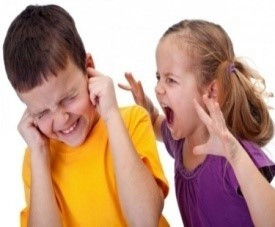
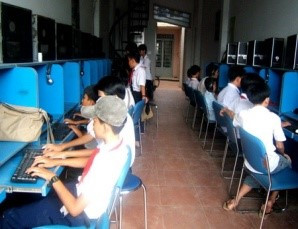
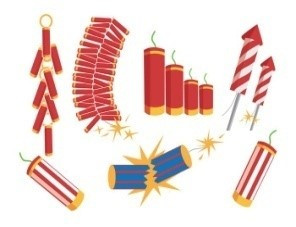
Đáp án:
Giải thích:
Trả lời:
A: What shouldn't children do at Tet?
B: Children shouldn’t buy crackers at Tet. It’s very dangerous.
Tạm dịch:
A: Trẻ em không nên làm gì vào ngày Tết?
B: Trẻ em không nên mua pháo hoa vào ngày Tết. Chúng thực sự nguy hiểm.
Bức tranh C. pháo hoa, pháo bông
Câu 3: Listen and tick A, B or C.
(Em hãy nghe và tích đáp án thích hợp)
What do you often do at Tet?

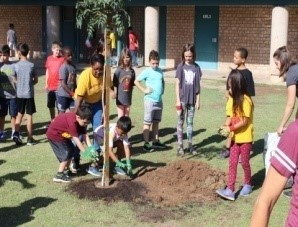
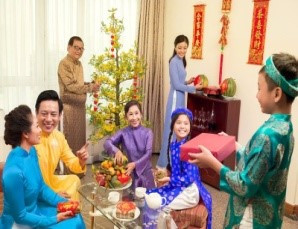
Đáp án:
Giải thích:
A: What do you often do at Tet?
B: We often plant trees around our school at Tet.
Tạm dịch:
A: Bạn thường làm gì vào ngày Tết?
B: Mình trồng cây xung quanh trường học.
Bức tranh B. trồng cây ở trường học
Câu 4: Listen and tick A, B or C.
(Em hãy nghe và tích đáp án thích hợp)
Do you eat a lot of food at Tet?
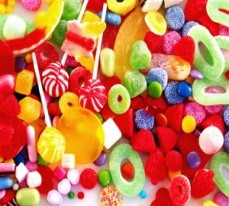
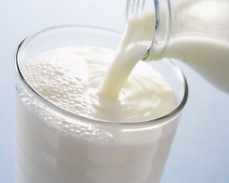
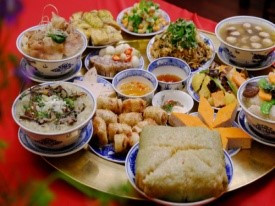
Đáp án:
Giải thích:
A: Do you eat a lot of food at Tet?
B: Yes, but my mother says I shouldn't eat too much. It’s not good for my health.
Tạm dịch:
A: Bạn có ăn nhiều đồ ăn trong ngày Tết không?
B: Có nhưng mẹ mình bảo không nên ăn quá nhiều. Nó không tốt cho sức khỏe.
Bức tranh C. đồ ăn ngày Tết
Câu 5: Listen and tick A, B or C.
(Em hãy nghe và tích đáp án thích hợp)
What should she do before Tet?



Đáp án:
Giải thích:
A: What should she do before Tet?
B: She should clean her house before Tet.
Tạm dịch:
A: Cô ấy nên làm gì trước ngày Tết?
B: Cô ấy nên dọn dẹp nhà cửa.
Bức tranh C. dọn dẹp nhà cửa
Câu 6: Listen and tick A, B or C.
What should children do at Tet?
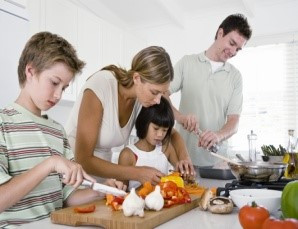
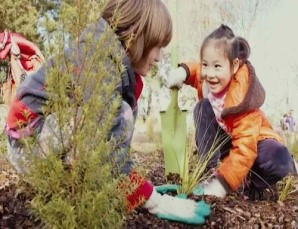

Đáp án:
Giải thích:
* Script:
A: What should children do at Tet?
B: They should help their mothers cook special food.
Tạm dịch:
A: Trẻ con nên làm gì vào ngày Tết?
B: Chúng nên giúp đỡ mẹ nấu ăn
Bức tranh A: Giúp đỡ mẹ nấu ăn
Xem thêm các bài trắc nghiệm Tiếng anh 6 Global Success hay, chi tiết khác:
Trắc nghiệm Unit 5: Natural wonders of Viet Nam
Trắc nghiệm Unit 6: Our Tet holiday
Trắc nghiệm Unit 7: Television
Trắc nghiệm Unit 8: Sports and games
Trắc nghiệm Unit 9: Cities of the world